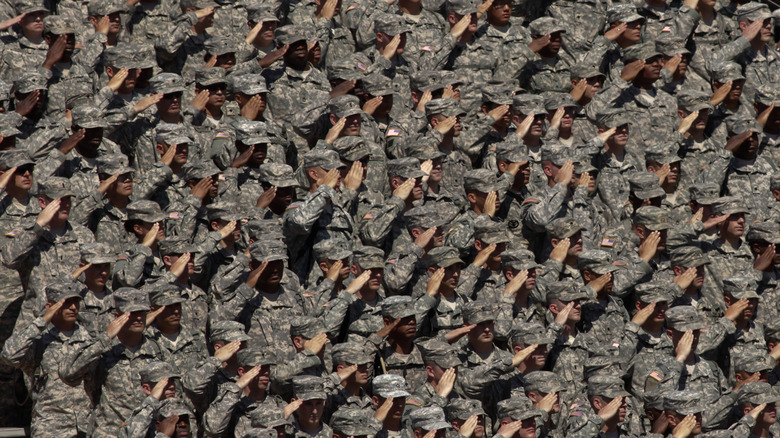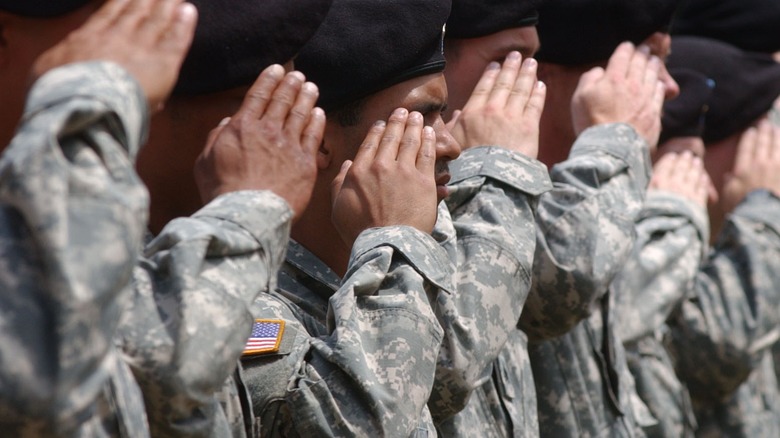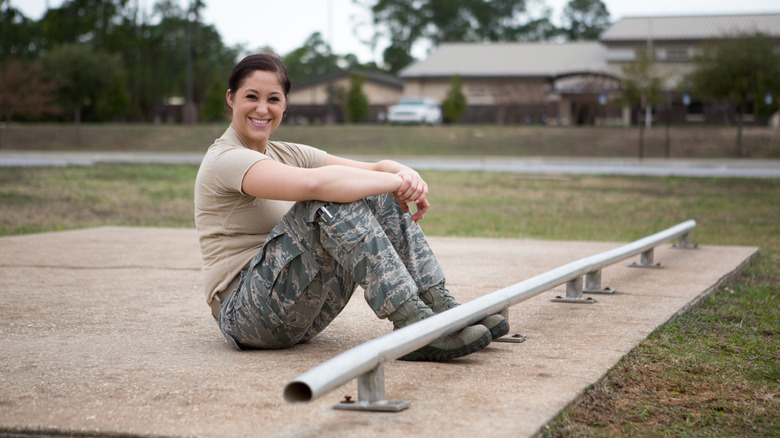Why Are Military Uniforms Called Fatigues? Here's What It Means
How we dress matters because it can help put us in the right state of mind. For soldiers, having the right clothing can affect whether or not they survive on the battlefield. When it comes to uniforms, they're often reminders that you are part of something bigger than yourself. They also carry symbols, which is why the American Flag can appear backwards on U.S. military uniforms (for a good reason). There are even strict rules around what is expected of service member when they are in uniform, such as limitations on vices, holding umbrellas, or even showing affection. But, why do military personnel refer to their uniforms as "fatigues" and what does it really mean?
While early American soldiers took inspiration from European armies for their uniforms — typically more formal — a wave of practicality (and going to war in different terrains) triggered the need for a different kind of clothing. Being a soldier means more than just charging into battle, there is also manual work in between. Although there is no single origin for where the term "fatigue" for the military uniform comes from, the USAMM shares that it's attributed to what soldiers referred to as the labor intensive work, which can lead to experiencing fatigue. Sometimes referred to as "utility uniforms," fatigues have shown how useful it can be when people are given the means to move more effectively.
The use of military fatigues in battle
Due to the increasingly global nature of war, the U.S. Department of Defense shared that fatigue uniforms were eventually developed for field use. For example, the Army used lightweight jungle fatigues to fit the weather during the Vietnam War. Apart from this, Heddels notes that the herringbone twill (HBT) fatigue variant was also in use during World War II. In recent times, the latest version of the uniforms use the latest technology to protect soldiers on the field from things like bugs, cold or fire.
Not too long ago, the Army tested apparel upgrades like adding a third arm for weapons stabilization. As technology progresses, it's possible that we'll see newer designs that are meant to support more non-combat functions as well. In fact, in the last decade, the US Army has introduced several structural changes to its uniforms, like added buttons and pockets, according to CNN. Plus, there's also a growing number of improvements to fit the female body more effectively.
There have been discussions about what it means for civilians to wear military paraphernalia, including the use of decorations. Twenty years ago, the 2005 Stolen Valor Act was established to help prevent non-military personnel from impersonating service members. In 2013, this act was amended to include additional badges, ribbons, and crosses. Apart from the experience of unjust acclaim and undue respect, this is primarily to deter people from getting benefits which are meant to support troops.
Should you wear military fatigues?
If you're a fan of the military look, but have not actually served, you may be wondering if you're entitled to wear a military fatigue outfit to your next Halloween party. Well, the answer is it depends. In reality, there are so many types of clothing that we enjoy today that have military origin. For example, Primer shares that we should thank the military for everything from the humble cardigan, bomber jackets, chinos, to even trench coats. Not to mention, there are plenty of ubiquitous accessories like Aviator sunglasses, combat boots, and dog tags that were once used to identify soldiers who have fallen in battle. With this, no one's going to arrest you if you walk around in camo pants or jackets.
As Heddels mentions, surpluses of fatigue uniforms have historically been sold to civilians before. Until today, many brands offer fatigue-inspired pants, which are great for many kinds of outdoors activities like hunting. In fact, if you want the real deal, you can even purchase vintage or deadstock military fatigues on eBay. However, a general rule of thumb when wearing military-like uniforms such as fatigues is that you do so without the intent to represent yourself as a service member (unless you are a veteran). On a practical note, this means making sure your look doesn't confuse other people and staying away from adding anything to your outfit that can be attributed to specific units or ranks.


